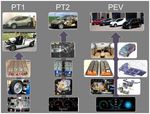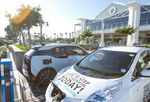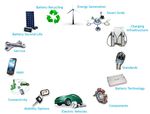SUSTAINABLE TRANSPORT AND MOBILITY FOR CITIES WORKSHOP - ETHEKWINI MUNICIPALITY HITEN PARMAR - DIRECTOR: UYILO EMOBILITY PROGRAMME ...
←
→
Page content transcription
If your browser does not render page correctly, please read the page content below
Sustainable Transport and Mobility for Cities Workshop - eThekwini Municipality
Hiten Parmar
Director: uYilo eMobility Programme
hiten.parmar@nmmu.ac.za
www.uYilo.org.zaPresentation Overview • SA Market: History, current and future of Electric Vehicle’s (EV) • EV Technology: Vehicle types, charging equipment • Efficient public transport options with zero emissions • Charging infrastructure options for electric city transport
Historical Background of EVs in South Africa
The early rise and fall of the electric car in South Africa is proceeded by four periods of interest:
(i) the collaboration of Department of Mineral and Energy Affairs and CSIR in the early 70s
DMEA together with the CSIR, researched and demonstrated the use of EVs as an alternative
to imported oil. More than 150 research papers resulted from the research and produced
a few vehicles converted to electric propulsion.
(ii) the National Energy Council / Eskom Programme (1988 – 2002)
Various vehicles were piloted and demonstrated – this time with technologies equaling to the
performance of conventional cars. Some of the vehicles were deployed in conventional
operations, e.g. the electric game viewer in the Kruger National Park, a utility vehicle as
part of the eThekwini fleet and two VW shuttle buses – one on Robben Island and the other
in Kyalami Business Park.Historical Background of EVs in South Africa
(iii) the Joule Project (2004 – 2012)
Optimal Energy development of the Joule – A local all electric family car.
Timing was not perfect and investors saw this as a risk. The Technology
Innovation Agency transferred the Optimal Energy assets to an initiative
established as the uYilo eMobility Technology Innovation Programme.
Source: AlphadotHistorical Background of EVs in South Africa (iv)Post COP 17 (2011 – present) South Africa started gearing-up after COP 17 for the introduction of EV technology across multiple organizations and government departments: •The Department of Trade and Industry (dti) EV Industry Roadmap for South Africa was launched in May 2013 •The Department of Environmental Affairs (DEA) was the first government department to launch its green fleet in 2013 •Electric Vehicle Infrastructure Alliance (EVIA), an initiative in 2014 by uYilo, SANEDI, GridCars, BMW and Nissan was developed to be a guide to the development of EV infrastructure hardware and software standards as well as the roll-out and positioning of recharging stations in South Africa. EVIA renamed as the Electric Vehicle Industry Association at the official launch in 2016. •Local market introductions of 100% Electric Vehicle offerings began with Nissan (Leaf in 2013), and BMW (i3 in 2015), and recently Mercedes Benz South Africa (2016) are listed as the first OEM to initiate local production of eMobility platforms with the establishment of the manufacture of the C-Class with the latest plug-in-hybrid technology for both local and export markets. •In 2015 Nissan SA and BMW SA signed a Memorandum of Understanding stipulating their collaborative efforts in the national implementation of Electric Vehicle charging infrastructure. •dti green transport study report (2016) identified national projects and initiatives as 18 electric vehicle based, 12 gas vehicles and 5 liquid biofuels.
EV Projects and Demonstrations in South Africa •Policy interventions through DoT (Green Transport Strategy and The Roads Policy), dti (Green Transport Study Report ) •UNIDO’s Low Carbon Transport South Africa Project (LCT SA) •SANEDI’s Cleaner Mobility Programme •The CSIR Energy Centre (EV Fleet) •uYilo E-Mobility Programme •GIZ Transport NAMA Project •E-Bike sharing schemes (Growthpoint, City of Tshwane pilot, University of Stellenbosch, NMMU) •EV Charging infrastructure roll outs (LCT SA, SANEDI’s Cleaner Mobility, City of Tshwane, City of Cape Town) •EV Public transport developments (MyCiTi e-Buses, 100% tuk-tuks by Mellow Cabs, the green cab, Futran system-concept stage) •Blue-Rock village •Awareness creation efforts- Solar challenge, low carbon race (WWF), Communications and PR Strategies to communicate the right message, EV Media masterclasses •Capacity building through EVIA workshops, myth busting sessions, EV training and manuals to guide stakeholders switching to an electric drive •Supporting of government departments in converting part of their fleet to EVs
South African landscape of public charging infrastructure
IDC, Sandton
12 national cities have a total of 95 stations
• 77 standard chargers (green)
• 18 fast chargers (blue)
BMW SA, Midrand
V&A Waterfront, Cape
Town
uYilo, Port ElizabetheMobility – Past, Present and Future. . .
2014 and beyond:
• Transition from early niche market to
mainstream consumers
• Many new technologies can be pulled
into the market
• ‘Big Ideas’ will play a pivotal role in
shaping the future of eMobility
Source: Gartner Hype Cycle; Urban Foresight LimitedGlobal Statistics
Source: IEA
• In 2011 global plug-in electric vehicles
(PEV) in were just 50,000 units
• Sales increased by about 80% in 2015
to 565,668 units
• Electric Vehicles (EV) and charging infrastructure deployment has continued growing exponentially since 2013
• Battery costs have come down while their energy density has climbed
• Vehicle electrification has gone multi-modal with 46,000 electric buses and 235 million electric two-wheelers deployed
• Total EV spending by EVI governments equaled 16 billion USD between 2008-2014Forbes.com Report: 8 February 2017
• The market for EV is currently growing by 60% year-on-year and there are already more than 1 million on the
roads
• Battery costs fell by 73% to $268/kWh in the seven years to 2015 and predicts they will reach $100/kWh by
2020 (US Department of Energy, Tesla)
• EVs will be cheaper than conventional internal combustion engines from 2020 and could have a fifth of the
road transport market by 2030 (Carbon Tracker)
• Cost of solar PV is 85% lower than it was seven years ago
• “Electric vehicles and solar power are game-changers that the fossil fuel industry consistently
underestimates. Further innovation could make our scenarios look conservative in 5 years’ time, in which
case the demand misread by companies will have been amplified even more.” (Senior researcher at Carbon
Tracker)Electric Mobility (eMobility)
WHY?
• Economic stability – transition of dependency on oil and coal towards sustainable and
renewable sources of energy
• Overall energy efficiency improvement across well-to-wheel within transportation
• Reduce emissions of Green-House-Gases in order to stabilize human-induced climate
change
HOW?
• Diversity of electric-mobility options
• Convenient charging infrastructure
• Smart grid networks using renewable energy and efficient energy management
• Consumer awarenessTransitions to eMobility in our every day lives
Energy Efficiency within Mobility
Source: SANEDIeMobility: Sustainable Product Life Cycle
• Vehicle manufacturers are developing sustainable and visionary concepts for mobility
• Sustainability now defines the product life cycle
Source: BMWeMobility Infrastructure Landscape
eMobility Infrastructure – Charging Scenarios
Residential: Charge time 6 – 8 hours
Mobile: Charge time 6 – 8 hours
Public: Charge time 1 – 6 hours Public: Fast Charging 15 – 30 minuteseMobility Infrastructure – New technologies
Battery swap stations
Port city of Qingdao
(China) battery units
of over 40 buses are
replaced two or three
times each day
Stationary wireless charging
Dynamic Wireless
Power Transfer
Dynamic wireless charging (DWPT)
systems on the
Strategic Road
Network (SRN)Vehicle-to-Grid (V2G) • Using vehicle battery as storage • Scheduling charging
eMobility Infrastructure – Vehicle-to-Everything (V2X)
• Vehicle-to-Infrastructure (V2I) - vehicle communication with infrastructure elements
• Vehicle-to-Vehicle Communication (V2V) - data between vehicles (IoT)
• Vehicle-to-Pedestrians (V2P) - communication between the vehicles and pedestrians
• Vehicle-to-Everything (V2X) - data exchange with other vehicles and roadside units and
infrastructureVehicle Connected Services – User-centric
Source: Frost & SullivanOverall Scenario Sustainability is about creating an awareness of our impacts on the people and the planet, to change behavioural patterns and innovate in ways to find solutions to environmental, social and economic issues, so that we can help to benefit the people and the planet today and in the future. Air quality is one of the most pressing global issues of our time for human beings. The cities of the world contribute disproportionately to environmental damage, as they currently produce around 75% of carbon emissions. With the present energy intensive modes of urban development and the predicted addition of three billion more city-dwellers by 2050, there is a need to take quick and large scale action to limit climate change. According to various reports from the UN, in 2015 the transport sector was responsible for around one quarter of energy related global greenhouse emissions from fossil fuel combustion, and one fifth of total energy use. The transport sector has the highest CO2 emissions growth of all sectors and is expected to grow one third by 2050. Transport touches almost every one of our lives on a daily basis. Whether you are driving your kids to school, riding on the train or bus to work, taking a flight to a well-deserved holiday destination. The importance of transport to economy and social wellbeing is undeniable, as is transport’s impact on the environment as a major contributor of damaging climate emissions and air pollution worldwide.
Future Trends Today’s economies are dramatically changing, triggered by development in emerging markets, the accelerated rise of new technologies, sustainability policies, and changing consumer preferences around ownership. Digitization, increasing automation, and new business models have revolutionized other industries, and automotive will be no exception. These forces are giving rise to four disruptive technology-driven trends in the automotive sector: diverse mobility, autonomous driving, electrification, and connectivity. Most industry players and experts agree that the four trends will reinforce and accelerate one another, and that the automotive industry is ripe for disruption. Electric vehicles are one of the most important ways to reduce motoring costs, reduce carbon use in transport, improve air quality and reduce global warming. Expect battery-powered vehicles to be 10% of the global market by 2020. Much of government economic stimulus packages for the auto industry have been linked to green tech, of which a huge proportion is things like battery technology. 16 million new cars a year are sold in EU alone. If we assume that up to 25% of the smallest car market could be electric cars within 10 years, that would mean over 1 million sold each year, at an average cost of EU11,000. Electric car sales would then be worth at least EU11bn a year in the EU.
Public transport options with zero emissions
Public transport’s GHG emissions can be broken down into two categories:
• emissions directly or indirectly by public transport operations and,
• emissions avoided as a result of its operations in a given region
The net carbon avoided is a result of the following:
Source: UITP
Mode shift – avoided car trips through more Congestion relief – reduced fossil fuel Land use – infrastructure and urban
use of public transport. On a per-passenger emissions as a result of reduced form are strongly linked to climate
kilometer basis, emissions from single- congestion. mitigation. As urban areas become
occupancy vehicles are on average four denser and come to rely more on public
times higher than the per-passenger transport, CO2 emissions are reduced.
kilometer emissions of public transport; these
figures are even higher during peak times.Public transport options with zero emissions
Public transport modes: buses
• Increase routes / Efficiency
• Cleaner fuels
• Electric buses / Hybrid buses / Hydrogen buses
• Fuel-efficient driving
• New bus lines / BRT
• Technological enhancements
Public transport modes: trains, trams (“shift” and “improve”)
• New lines and extensions
• Increased efficiency: technological enhancements, eco-driving and regenerative breaking
Combined mobility:
• Taxi
• Shared Transport Systems : Car-sharing / Bike-sharing
• Walking
• CyclingPublic transport options with zero emissions
Improvements and investments in infrastructure
• Green procurement
• Energy efficiency
• Station enhancements
• Office building eco-design
• Energy production
Awareness and action
• Stakeholder engagement
• External stakeholder engagement
• Carbon reduction strategiesCharging infrastructure options for electric city transport
Automated fast charging system
Battery Swapping
Source: ABB
Typical charge time of 4–6 minutes
Battery units replaced two or three times each day
Fully automated rooftop charging connection
Port city of Qingdao, China
Zurich, SwitzerlandCharging infrastructure options for electric city transport
Dynamic charging
Inductive charging (Wireless)
Conductive charging includes the use of physical connections
Sweden
Transfers power through a magnetic fieldSMART Revolution
Source: Google images
eMobility holds great promise for economic growthuYilo eMobility Technology Innovation Programme
Tel: +27 (0)41 504 3608
Email: uYilo@nmmu.ac.za
Web: www.uYilo.org.zauYilo eMobility Technology Innovation Programme
• Initiated in 2013 as a national multi-stakeholder technology development
programme to support the creation of products and services for the eMobility
industry in South Africa
• Provide Engineering Services, Specialised Facilities and Seed Funding for
eMobility technology development
• Facilitate and co-ordinate eMobility Projects and Initiatives
• Seek to create multi-disciplinary teams that encompass government, industry and
academia to support eMobility in South Africa
Key focus areas: battery technologies / systems,
charging systems / grid integration and drive train technologies,
enveloped by skills developmentuYilo’s Multi-Departmental Approach
uYilo e-Mobility Eco-System
Integrate and
accelerate development
and commercialisation
of the various
technology
areas
Source: P3 Engineering (Pty) LtdInternal and External Activities
1. National Battery Testing Laboratory
2. Electric Vehicle Systems Laboratory for component support
3. Live Testing Environment for Research, Testing, Development and
Demonstration
- Electric Vehicle Industry Association (EVIA)
- Public Private Sector consortium to shape and simulate the local EV environment
- SABS / NAAMSA working group representation
- Battery system standards
- EV charging standards
- uYilo Kick Start Fund
- An agile mechanism to fund demonstration, product development or research in:
Energy Storage
Niche EV Components
Charging Network InfrastructureThank You www.uYilo.org.za
You can also read



























































